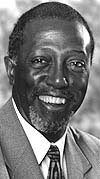|
Subscribe / Renew |
|
|
Contact Us |
|
| ► Subscribe to our Free Weekly Newsletter | |
| home | Welcome, sign in or click here to subscribe. | login |
Architecture & Engineering
| |
 |
July 24, 2003
High-tech design ushers UW Law into 21st century
UW School of Law

Knight
|
The outdoor terrace, which will have a vine-covered trellis and bench seating, surrounded by tasteful landscaping, is almost finished. On the inside, once-bare concrete floors are now carpet-covered; elevators and light fixtures are installed; and the communications infrastructure that will support a completely connected environment is being placed.
State-of the-art voice, data and video cables connect computer and telecommunications technology that enable “smart podiums” with built-in touch screens, Internet access and video-conferencing systems. And a backbone network with hard-wired ports, as well as a far-reaching wireless network, will permit Internet access from virtually anywhere in the building, and even outside on the terrace.
21st-century education
Even though the role of attorneys has changed and continues to evolve, the University of Washington School of Law’s mission has remained constant since its foundation in 1899: to provide the highest quality legal education, and an environment that is conducive to learning.
By blending the rich traditions and history of the law with new technology, the law school looks to lead the design and delivery of legal and professional education in the 21st century.
The structural design limitations and lack of space in Condon Hall limited the expansion and evolution of the law school’s program. Gates Hall will especially benefit users of the UW law library, the largest west of Minneapolis and north of Berkeley, and a vital resource for the Northwest legal community.
The old library was overcrowded and divided inefficiently among seven floors, inconveniencing people and creating security problems. A quarter of the collection was in the basement, not easily accessed by users.
Enhanced student spaces
The new library will be far more accessible and efficient. As in all great law schools, the library will be the heart and soul of our new home. Located on floors L1 and L2, the library includes 12 team-study rooms, spacious tables and carrels for library users, and more than 560,000 volumes for research and study.
The new building offers many enhanced student spaces, including a 28-person computer lab, a student-only lounge in the library and even a coffee shop.
The wood-paneled Magnuson/Jackson Moot Courtroom and the Toni Rembe Appellate Courtroom offer students a realistic courtroom experience, where efforts can be both recorded and broadcast.
In addition, all areas of the building will be wireless, allowing students and other patrons to conduct research or to communicate with each other easily. Terminals for e-mail and quick study projects will be located near the entrance of the library. In contrast to Condon Hall, most of the collection will be in open stacks, with aisles that accommodate persons with disabilities.
Because Gates Hall is approximately 35 percent larger than Condon Hall, all faculty, staff and students will be housed under one roof for the first time in more than 20 years!
The clinical law program will make its new home on the second floor, while development and alumni-relations staff, and the offices of conferences and continuing education that currently occupy two small houses across the street from Condon Hall, will all be located on the third floor.
Law schools are central to a university’s mission because the law is intertwined with every discipline. The location of Gates Hall will provide a strong university presence, one that welcomes colleagues from across campus, once again reaffirming the school’s role as a vital part of the university community.
‘Expression of openness’
Dan Jardine, a UW graduate and one of the project’s architects, described the building’s L shape, which faces Memorial Way, as an “expression of openness. We also wanted to emphasize the transparency ... by using a lot of glass, so there is a sense of life, movement and intimacy.”
Practicing law in this new century has changed as the complexity of the issues involved grows. Legal policy and professional practice today are, by necessity, complex and global.
While key elements such as integrity, trust and candid counsel remain the hallmarks of the profession, new educational approaches must encourage today’s lawyers to work collaboratively, to address the political and social issues of the day with people of varied and diverse backgrounds and disciplines.
As we are working on a new strategic plan that will guide our efforts over the next decade, the University of Washington School of Law is about to enter a new era.
W.H. “Joe” Knight Jr. is dean of the University of Washington School of Law.
Other Stories:


